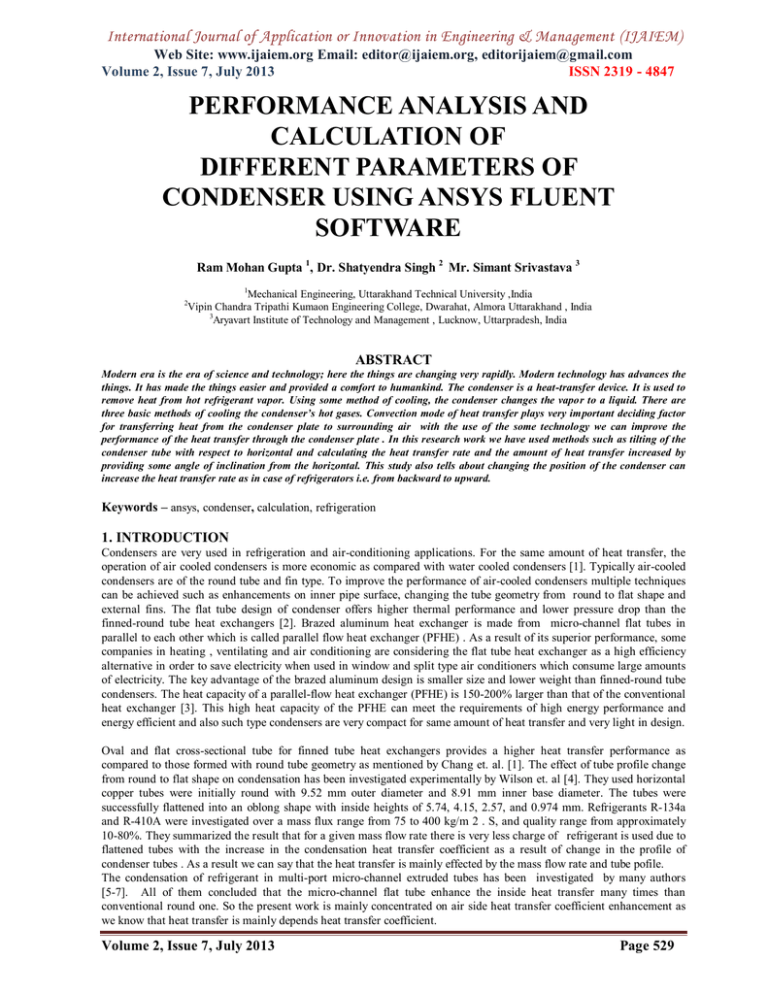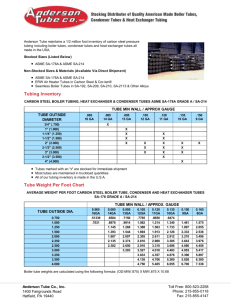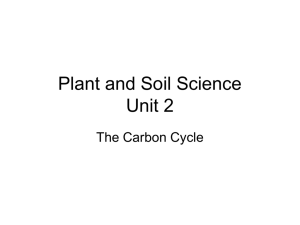PERFORMANCE ANALYSIS AND CALCULATION OF DIFFERENT PARAMETERS OF CONDENSER USING ANSYS FLUENT
advertisement

International Journal of Application or Innovation in Engineering & Management (IJAIEM) Web Site: www.ijaiem.org Email: editor@ijaiem.org, editorijaiem@gmail.com Volume 2, Issue 7, July 2013 ISSN 2319 - 4847 PERFORMANCE ANALYSIS AND CALCULATION OF DIFFERENT PARAMETERS OF CONDENSER USING ANSYS FLUENT SOFTWARE Ram Mohan Gupta 1, Dr. Shatyendra Singh 2 Mr. Simant Srivastava 3 1 Mechanical Engineering, Uttarakhand Technical University ,India Vipin Chandra Tripathi Kumaon Engineering College, Dwarahat, Almora Uttarakhand , India 3 Aryavart Institute of Technology and Management , Lucknow, Uttarpradesh, India 2 ABSTRACT Modern era is the era of science and technology; here the things are changing very rapidly. Modern technology has advances the things. It has made the things easier and provided a comfort to humankind. The condenser is a heat-transfer device. It is used to remove heat from hot refrigerant vapor. Using some method of cooling, the condenser changes the vapor to a liquid. There are three basic methods of cooling the condenser’s hot gases. Convection mode of heat transfer plays very important deciding factor for transferring heat from the condenser plate to surrounding air with the use of the some technology we can improve the performance of the heat transfer through the condenser plate . In this research work we have used methods such as tilting of the condenser tube with respect to horizontal and calculating the heat transfer rate and the amount of heat transfer increased by providing some angle of inclination from the horizontal. This study also tells about changing the position of the condenser can increase the heat transfer rate as in case of refrigerators i.e. from backward to upward. Keywords – ansys, condenser, calculation, refrigeration 1. INTRODUCTION Condensers are very used in refrigeration and air-conditioning applications. For the same amount of heat transfer, the operation of air cooled condensers is more economic as compared with water cooled condensers [1]. Typically air-cooled condensers are of the round tube and fin type. To improve the performance of air-cooled condensers multiple techniques can be achieved such as enhancements on inner pipe surface, changing the tube geometry from round to flat shape and external fins. The flat tube design of condenser offers higher thermal performance and lower pressure drop than the finned-round tube heat exchangers [2]. Brazed aluminum heat exchanger is made from micro-channel flat tubes in parallel to each other which is called parallel flow heat exchanger (PFHE) . As a result of its superior performance, some companies in heating , ventilating and air conditioning are considering the flat tube heat exchanger as a high efficiency alternative in order to save electricity when used in window and split type air conditioners which consume large amounts of electricity. The key advantage of the brazed aluminum design is smaller size and lower weight than finned-round tube condensers. The heat capacity of a parallel-flow heat exchanger (PFHE) is 150-200% larger than that of the conventional heat exchanger [3]. This high heat capacity of the PFHE can meet the requirements of high energy performance and energy efficient and also such type condensers are very compact for same amount of heat transfer and very light in design. Oval and flat cross-sectional tube for finned tube heat exchangers provides a higher heat transfer performance as compared to those formed with round tube geometry as mentioned by Chang et. al. [1]. The effect of tube profile change from round to flat shape on condensation has been investigated experimentally by Wilson et. al [4]. They used horizontal copper tubes were initially round with 9.52 mm outer diameter and 8.91 mm inner base diameter. The tubes were successfully flattened into an oblong shape with inside heights of 5.74, 4.15, 2.57, and 0.974 mm. Refrigerants R-134a and R-410A were investigated over a mass flux range from 75 to 400 kg/m 2 . S, and quality range from approximately 10-80%. They summarized the result that for a given mass flow rate there is very less charge of refrigerant is used due to flattened tubes with the increase in the condensation heat transfer coefficient as a result of change in the profile of condenser tubes . As a result we can say that the heat transfer is mainly effected by the mass flow rate and tube pofile. The condensation of refrigerant in multi-port micro-channel extruded tubes has been investigated by many authors [5-7]. All of them concluded that the micro-channel flat tube enhance the inside heat transfer many times than conventional round one. So the present work is mainly concentrated on air side heat transfer coefficient enhancement as we know that heat transfer is mainly depends heat transfer coefficient. Volume 2, Issue 7, July 2013 Page 529 International Journal of Application or Innovation in Engineering & Management (IJAIEM) Web Site: www.ijaiem.org Email: editor@ijaiem.org, editorijaiem@gmail.com Volume 2, Issue 7, July 2013 ISSN 2319 - 4847 INDENTATIONS AND EQUATIONS 2 h air-side heat transfer coefficient, W/m K Dh hydraulic diameter, mm Vf Air face velocity, m/ s H transverse pitch of parallel tubes. mm L Width of flat tube cross section, mm Ar Aspect ratio =H/L P β pressure drop for case of inclined flat tubes by angle β, Pa. P0 pressure drop for case of parallel flat tubes with β=0 deg. β inclination angle of flat tubes with respect to horizontal, deg. Re Reynolds number, dimensionless PFHE parallel flow heat exchanger (Aluminum Brazed heat exchanger = PFHE or serpentine flow heat exchanger) η overall performance = Kh/KP Kh Enhancement factor of h = hβ/h0 KP pressure drop increase factor= Pβ/P0 ε effectiveness (0 < ε ≤ 1) NTU number of transfer units The formulas which are used for the calculation of the different parameters are as follows . Qc = m . r ( h 3 – h 2 ) = ma cpa ( Tco – Tci ) = εcd Qc max MATHEMATICAL MODEL Many industrial applications and research work, such as air cooling in the coil of an air conditioner, can be modeled as two-dimensional heat flow. All parameters such as tube diameter length and thickness are first modeled on CATIA software. And such model is then imported to the ansys software which can generate the pre-generated meshes and then the studies were done on the ansys software . Then modeled as bank of tubes in cross-flow, and the air outside flow is classified as turbulent and steady. The model is used to predict the Flow and temperature fields that result from convective heat transfer. Due to symmetry of the tube bank, only a portion of the geometry was modeled in CATIA software . Domain is discretized into a finite set of control volumes or cells. General transport equations for mass, momentum and energy are applied to each cell and discretized . The governing equations are solved for studying flow field. The numerical solution was conducted to investigate the influence of inclination angle (β) and aspect ratio (Ar) on the performance of air cooled condensers. The following values which applicable to window and split air conditioning systems, are used as input data for solving the studied problem: 1 . Air flow is steady, two dimensional and turbulent 2. Air face velocity (Vf) =3 3. The condenser saturation temperature of refrigerant=318 K. Hence study is based on constant wall Temperature = 318 K 4 . Ambient air temperature = 300 K FIGURES AND TABLES The following configuration Is basically used for the analysis . Which is first modeled as in four cases as shown in figure. and the performance is calculated using ansys software Volume 2, Issue 7, July 2013 Page 530 International Journal of Application or Innovation in Engineering & Management (IJAIEM) Web Site: www.ijaiem.org Email: editor@ijaiem.org, editorijaiem@gmail.com Volume 2, Issue 7, July 2013 ISSN 2319 - 4847 As shown in above figure the configuration of condenser is used for the analysis. The following physical data was taken for the analysis of the condenser including different parameters. Condenser configurations Diameter of the tube Figure 2. Physical dimension of the condenser Values 5.03 Unit mm Distances between the tubes 27.92 mm Thickness of the tube 0.71 mm Length of the tube 469.9 mm Calculation of condenser tubes with horizontal configuration. Calculation for Forward condenser Volume 2, Issue 7, July 2013 Page 531 International Journal of Application or Innovation in Engineering & Management (IJAIEM) Web Site: www.ijaiem.org Email: editor@ijaiem.org, editorijaiem@gmail.com Volume 2, Issue 7, July 2013 ISSN 2319 - 4847 Calculation for Backwards tubes Calculation for Convergent divergent calculation Volume 2, Issue 7, July 2013 Page 532 International Journal of Application or Innovation in Engineering & Management (IJAIEM) Web Site: www.ijaiem.org Email: editor@ijaiem.org, editorijaiem@gmail.com Volume 2, Issue 7, July 2013 ISSN 2319 - 4847 RESULTS AND DISCUSSION In order to study the performance of the proposed cases, the obtained results are presented relative to those of parallel flat horizontal tubes at the same operating conditions. Contour lines for temperature are shown convergent divergent. Generally, it is observed from that there is a decrease in fluid temperature towards the centre between pipes in flow direction as the flow is developing. The effect of inclination angle β on the performance of flat tube air cooled condenser is illustrated in Figure. It is also observed from the figures that with the use of convergent divergent type’s tubes we can enhance the heat transfer rate. With the result obtained we can predict that if we change the place of condenser in refrigerator the performance can also improve. CONCLUSION Using the proposed convergent divergent construction of condenser enhance the heat transfer coefficient. To keep the production line that manufacturing the PFHE, the proposed placement of condenser is top position in the refrigerator. This proposed heat exchanger is the strong candidate for use in industrial applications, which is named ‘convergentdivergent flow heat exchanger. REFERENCES [1.] Y. P. Chang, R. Tsai , J. W. Hwang : Condensing Heat Transfer Characteristics of Aluminum Flat Tubes, in Applied Thermal Engineering, 1997, Vol. 17, No. 11, pp. 10551065 [2.] R. L. Webb, X. M. Wu : Thermal and Hydraulic Analysis of a Brazed Aluminum Evaporator, in Applied Thermal Engineering, 2002, 22: 1369-1390 [3.] K. Chung, K. S. Lee, W. S. Kim: Optimization of the Design Factors for Thermal Performance of a Parallel Flow Heat Exchanger, in Int. J. of H&M Transfer, 2002, 45: 4773-4780 [4.] M. J. Wilson, T. A. Newell, J. C. Chato, C. A. Ferreira: Refrigerant Charge,Pressure Drop, and Condensation Heat Transfer in Flattened Tubes, in Int. J. Refrigeration, 2003, 26: 442- 451 [5.] J. W. Coleman, S. Garimella: Characterization of Two Phase Flow Patterns in Small Diameter Round and Rectangular Tubes, in International Journal of Heat and Mass Transfer, 1770, 31 "0888# 1758 Volume 2, Issue 7, July 2013 Page 533 International Journal of Application or Innovation in Engineering & Management (IJAIEM) Web Site: www.ijaiem.org Email: editor@ijaiem.org, editorijaiem@gmail.com Volume 2, Issue 7, July 2013 ISSN 2319 - 4847 [6.] E. Bari, J. Y. Noel, G. Comini, G. Cortella : Air-cooled Condensing Systems for Home and Industrial Appliances , in Applied Thermal Engineering, 2002, 25:1446-1458 [7.] H. K. Varma, C. P Gupta: Heat Transfer during Forced Convection Condensation inside Horizontal Tube, in Int . J. Refrigeration, 1995, 18:210-214 [8.] F. F. Araid, M. A. Shalaby, M. M. Awad: Convective Heat Transfer to Gas Flow in Converging Diverging Tubes, in Mansoura University Bulletin, June 1986, V, 11, No. 1 [9.] L. H. Rabie, A. A. Sultan, Y. E. Abdel Ghaffar: Convective Heat Transfer and Pressure Drop in Periodically Convergent Divergent Variable Area Annuli, 2001, IMPEC12 [10.] M. H. Kim, S. Song, C. W. Bullard: Effect of Inlet Humidity Condition on the Air Side Performance of an Inclined Brazed Aluminium Evaporator, in I. J. of Refrigeration, 2002, 25: 611-620 [11.] G. Lazza, U. Merlo: An Experimental Investigation of Heat Transfer and Friction Losses of Interrupted and Wavy Fins for Fin-and-Tube Heat Exchangers, in Int. J. Refrigeration, 2001, 24: 209-416 [12.] S. Sanitjai, R. J. Goldstein: Forced Convection Heat Transfer from a Circular Cylinder in Cross Flow to Air and Liquids, in International Journal of Heat and Mass Transfer, 2004, 47: 4795-4805 [13.] J. S. Jabardo, G. W. Manami, M. R. Lanella: Modeling and Experimental Evaluation of an Automotive Air Conditioning System with a Variable Capacity Compressor, in Int. J. of Refrigeration, 2002, 25: 1157-1172 [14.] X. M. Wu, R. L. Webb: Thermal and Hydraulic Analysis of a Brazed Aluminum Evaporator , in Applied Thermal Engineering, 2002, 22: 1369-1390 [15.] C. Y. Yang, R. L. Webb: Condensation of R-12 in Small Hydraulic Diameter Extruded Aluminum Tubes with and without Micro-Fins, in I. J. of H&M Transfer, 2005, 39:791-800 [16.] A. Bensafi, S. Borg, D. Parent: CYRANO: a Computational Model for the Detailed Design of Plate–Fin-and Tube Heat Exchangers using Pure and Mixed Refrigerants, in Int. J. Refrigeration, 1997, Vol. 20, No. 3:218-228 Proceedings Papers: AUTHOR Ram Mohan Gupta Pur. M-Tech (Thermal Engineering) Uttrakhand Technical University , Dehradun Volume 2, Issue 7, July 2013 Page 534





